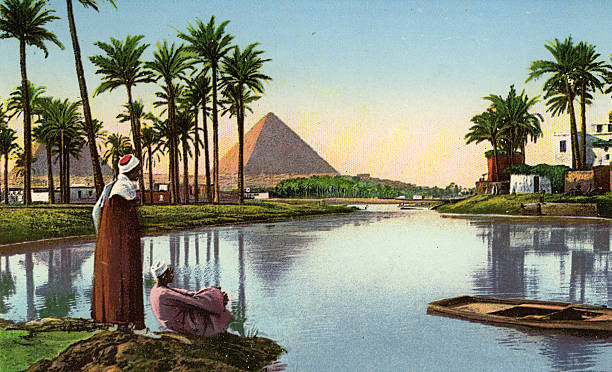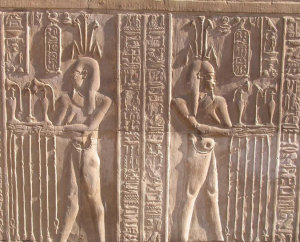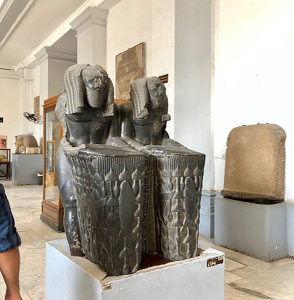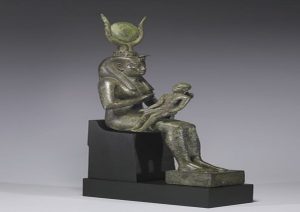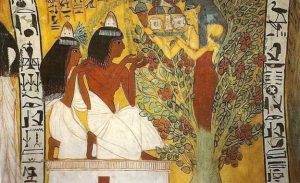The Nile is in the veins of the Egyptians.
The Nile is considered the lifeline for Egyptians. Ancient Egyptians were accustomed to living on its banks. The annual Nile flood was a crucial event, marking the beginning of their year. They revered the Nile as the god of fertility and prosperity, Hapi. The Egyptians studied the Nile’s geography and traced its source to Abyssinia. In every region, there was a Nile meter to measure water levels, which determined tax rates. A good Nile flood, reaching 16 cubits (8 meters), ensured a prosperous year. Landowners paid taxes based on their livestock and crops. If the water level was too low or too high, no taxes were imposed.
The Naming of the Nile
The ancient Greeks named the Nile River after a blue-flowering water lily that grew along its banks, which they called “Nilus.” This plant was used in cleaning clothes and give water blue color.
The God Hapi
The Egyptians depicted the Nile god Hapi as a man wearing a crown adorned with papyrus and lotus plants, symbolizing Upper and Lower Egypt. Hapi’s body exhibited some feminine features such as large breasts and a full belly. The masculine aspects of the god signify strength, growth, and fertility. The feminine aspects represent giving. This highlights the concept of the Nile as the bringer of growth and abundance.
The Nile Flood
The Nile flood was a cause for great joy among the ancient Egyptians. They eagerly anticipated the annual flooding. If the flood was delayed, was too small, or failed to occur, the Egyptians feared famine, disease, and societal upheaval. In times of low or no flood, they would pray to Isis, the goddess of motherhood, for relief. According to ancient Egyptian mythology, Isis’ tears created the Nile River. Because the Nile originates in Aswan, a temple to Isis was built there at Philae.
The Nile’s Bride
There’s a misconception that the ancient Egyptians sacrificed a young woman to the Nile if there was no flood. In reality, they would throw statues of women into the river as a symbolic offering.
The Nile Celebrations
The Nile flood typically began in July and could last up to 100 days, ending in late September. The Egyptians celebrated this annual event with great enthusiasm. For them, the flood signified the start of the agricultural cycle, bringing life and prosperity. The Nile deposited rich silt on the land, fertilizing it for farming. The strong current of the flood made it easier for boats to travel from the south to the north. The flood also brought with it an abundance of fish and birds. Each of Egypt’s 42 provinces had its own celebrations.
The Sanctity of the Nile to the Ancient Egyptians
The ancient Egyptians believed that the Nile was the source of all life and held it in great reverence. A common saying among them was, “Whoever drinks from the Nile must return to it.” Throughout their history, regardless of their religious beliefs, the Egyptians considered the Nile to be the river of paradise. The Book of the Dead, an ancient Egyptian funerary text, states that polluting the Nile was one of the gravest sins. In Chapter 125, the deceased declares that they have not polluted the Nile, emphasizing the severity of such an act. Ancient Egyptians took great care to purify the water they drank. They would often add moringa seeds to their water vessels, a practice recently validated by a Penn State University study that found moringa has antibacterial properties. It’s remarkable to discover how advanced the ancient Egyptians were in their knowledge, that we are only now fully appreciating over 5,000 years later.
A scene depicting the god Hapi on the walls of the Kom Ombo Temple offering sacrifices and goodness)
The Nilometer in the city of Aswan
A double statue representing the Nile in Upper and Lower Egypt during the reign of King Amenemhat III and was found in Tanis
A statue of the goddess Isis, goddess of motherhood, breastfeeding Horus

